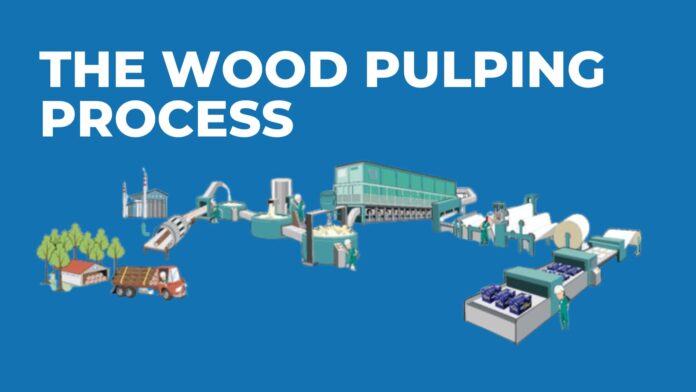The wood pulping process is a critical aspect of the paper manufacturing industry. It is a process where wood as the raw material is transformed into a fibrous material which is suitable for creating paper and other wood-based products.
This process is not only essential for paper production but also to contribute to the efficient use of natural resources with pulp being used for many applications including packaging, hygiene products and specialty papers.
In this blog, we will explore the wood pulping process step by step and understand the process while discussing the machinery involved in this process, and some leading manufacturers of the wood pulping equipment.
What is Wood Pulping?
Wood pulping is the process of breaking down wood into its fibrous components, primarily cellulose, which is essential for paper production. This process involves several mechanical and chemical steps to ensure the wood is adequately transformed while maximizing resource use and minimizing waste. The goal is to extract cellulose while removing lignin and other components that could affect the paper’s quality and durability.
Steps involved in the Wood Pulping Process
- Debarking
The first step in the wood pulping process is debarking. The wood logs are processed through a debarking machine, where the machine removes the bark from the logs. This is necessary as the bark does not contribute to high-quality pulp and can hinder the pulping process.
Debarking is typically achieved through rotating drums or hydraulic debarkers that strip the bark from the logs without damaging the wood. Removing the bark also helps reduce unwanted contaminants, resulting in a cleaner pulp. - Chipping
Once the logs are debarked, they move on to the chipping process. Here, large wood pieces are cut into uniform, small chips with the help of a chipper machine to enhance the efficiency of later processes. Uniform chip sizes allow for even cooking, which is essential in achieving high-quality pulp. Drum or disc chippers are commonly used to produce these chips, with adjustable settings to maintain consistency in chip size.
- Cooking
The next step in wood pulping process is cooking. The cooking process is also known as “digestion”. This involves chemically breaking down the wood chips to release cellulose fibers. Chips are cooked with chemicals (typically sodium hydroxide and sodium sulfide in the kraft process) under high pressure and temperature, which dissolves lignin.
This step is very important as it determines the strength, brightness, and texture of the final pulp. Depending on the type of pulp required, cooking times and temperatures vary, making precise control essential.
- Pulping
In the pulping stage, the wood chips are converted into pulp, which can be done through mechanical, chemical, or semi-chemical methods. Mechanical pulping uses physical forces to separate fibers, whereas chemical pulping (e.g., kraft or sulfite pulping) uses chemicals to dissolve lignin. Mechanical pulping is energy-intensive but retains more lignin, making the paper slightly yellowish. Chemical pulping, on the other hand, produces stronger and more durable paper products.
- Washing and Screening
In the next step in wood pulping process after pulping, pulp is washed to remove residual chemicals, lignin, and other impurities. This step ensures the pulp is clean and suitable for paper production.
The screening process further refines the pulp by removing larger, unbroken pieces, or “knots,” which didn’t fully break down in the cooking process.
- Bleaching (Optional)
The bleaching process in the wood pulping process is dependent on the final product requirements. For white or bright paper products, the pulp undergoes a bleaching process, which further removes residual lignin. This step is optional and depends on the intended use of the pulp. Bleaching involves treating the pulp with various chemicals, such as chlorine dioxide or hydrogen peroxide, to achieve the desired brightness level.
In the final stage, the pulp is dried to the desired moisture content. The drying process usually involves pressing and drying machines that reduce water content, making the pulp more manageable and suitable for storage or immediate paper production.
Key Machinery in the Wood Pulping Process
The wood pulping process involves various specialized machinery to ensure efficient high-quality pulp production. Let’s see the machinery used in wood pulping process one by one.
- Debarkers
Debarkers, such as drum or ring debarkers, are designed to remove bark from logs. They are crucial for producing clean, quality pulp and reducing contaminants.
- Chippers
Chippers, including drum and disc chippers, slice debarked wood into consistent, small chips, which are essential for even cooking and efficient fiber release.
- Digesters
Digesters are used in the cooking process to chemically dissolve lignin and separate cellulose fibers. These vessels operate under high pressure and temperature and are integral to chemical pulping methods.
- Pulp Washers and Screens
Pulp washers and screens are used in the washing and screening stages to remove unwanted chemicals, lignin, and large wood particles from the pulp, ensuring its purity.
- Bleaching Equipment
For pulp requiring higher brightness, bleaching towers and reactors are used to treat the pulp with chemicals, making it whiter and more suitable for high-quality paper products.
- Presses and Dryers
In the drying process, pulp presses and dryers remove excess moisture, preparing the pulp for storage or further processing.
Every machine involved in the wood pulping process is crucial and needs to be best of the quality. Now let’s see the top manufacturers of the pulp and paper machines who can provide you with the best quality machinery.
Leading Manufacturers of Wood Pulping Machinery
Many companies specialize in producing high-quality wood pulping machinery. Some of the prominent manufacturers include:
- Valmet
Known globally for its sustainable solutions, Valmet offers an extensive range of machinery for the wood pulping process, including digesters, washers, and chipping equipment.
- Parason
Parason is one of the global leaders for pulp and paper machinery manufacturing and supplying. Their agro and wood machinery are known for the best quality and longer life. Parason provide every kind of pulping machines for wood pulping process. - ANDRITZ
ANDRITZ is one of the leading suppliers of equipment for wood processing and pulp production. Their machinery, from debarkers to advanced pulp screening and washing equipment, is renowned for efficiency and innovation.
- Voith
Voith provides state-of-the-art technology for wood pulping and paper production, focusing on energy-efficient and environmentally friendly solutions.
- Kadant
Kadant is known for its comprehensive range of pulping equipment, including chippers and screening technology, making it a prominent player in the wood pulping industry.
If you are looking for the wood pulping process machinery you can contact us, and we will guide you to the best manufacturer as per your requirement. Our team of experts will understand your need in detail and answer each of your query.
Conclusion
The wood pulping process is an important and complex process involving many steps. These steps required multiple machines specialized for each step. Each stage, from debarking to drying, plays a crucial role in ensuring the quality and efficiency of pulp production. Advanced machinery, from debarkers to bleaching reactors, supports each step, with manufacturers like Valmet, Parason, ANDRITZ, and Voith at the forefront of innovative wood pulping technology. Understanding the intricacies of this process helps companies make sustainable and high-quality products that meet global demands for paper, packaging, and more.

